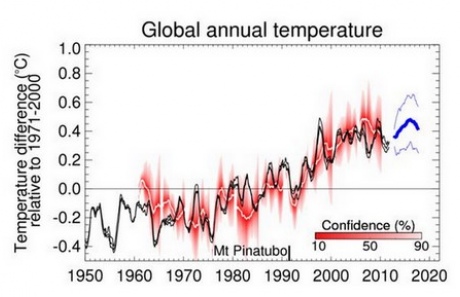Forecasting future global temperatures

A discussion of recent data from the Met Office on future global temperatures by Professor Sir Brian Hoskins, Grantham Institute Director.
The current news item that the Met Office now predicts no global warming in the period up to 2017 is based on the latest 5-year forecast run with their new climate model. Such forecasts are at the frontiers of the subject and form part of a research programme in this area in the Met Office and elsewhere. The present level of scientific knowledge related to such forecasts is not high enough that they can be considered to be predictions.
However they are certainly interesting as they are performed with a very good model that includes the expected increase in greenhouse gases, small changes in solar radiation and the runs are started with our best knowledge of the current state of the ocean as well as other parts of the climate system.
The graph below, taken from the Met Office web site, shows up to 2011 the actual temperatures in black, the average of their results starting from times at 5-year intervals in the past in white, and the range of these in red. For the future period up to 2017 the mean of the model results and their range is shown in blue.

Many runs of the model are performed. The average of them (shown in the thick blue line) indicates a level of global warmth comparable to that in the warmest years since 1998. This has been interpreted as an expectation of no warming from 1998 until 2017. However a number of aspects should be noted:
- Half the years in the period to 2017 would be expected to be at new record global temperatures according to the model
- Smoothing the temperature record, both the past and the model mean, on a multi-decadal time-scale would still show a world warming continuously up to 2017
- The rapid increase in temperature in the 1990s and the more recent levelling off are consistent with mathematical analyses that describe the record as a mixture of a trend and multi-decadal variability (MDV). In times when the MDV gives warming then the total warming is large. At other times, such as now, when the MDV gives cooling then the total warming is small. When the MDV starts to give warming again a period of rapid warming can be expected.
Article text (excluding photos or graphics) © Imperial College London.
Photos and graphics subject to third party copyright used with permission or © Imperial College London.
Reporter
Press Office
Communications and Public Affairs
- Email: press.office@imperial.ac.uk
